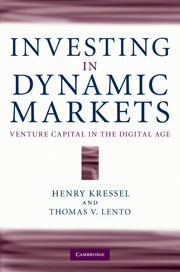Book contents
- Frontmatter
- Contents
- List of figures
- List of tables
- Acknowledgments
- Introduction
- 1 Hot markets, investment waves, bubbles, charlatans
- 2 Financing high-risk businesses
- 3 Venture investing: An uncertain science
- 4 Investing in a transformed market: Telecommunications
- 5 Investing in a transformed market: Semiconductors
- 6 Investing in early-stage technology: The Internet in the 1990s
- 7 Software products and services
- 8 Venture capital: Past and future
- Appendix
- Bibliography
- Index
1 - Hot markets, investment waves, bubbles, charlatans
Published online by Cambridge University Press: 06 July 2010
- Frontmatter
- Contents
- List of figures
- List of tables
- Acknowledgments
- Introduction
- 1 Hot markets, investment waves, bubbles, charlatans
- 2 Financing high-risk businesses
- 3 Venture investing: An uncertain science
- 4 Investing in a transformed market: Telecommunications
- 5 Investing in a transformed market: Semiconductors
- 6 Investing in early-stage technology: The Internet in the 1990s
- 7 Software products and services
- 8 Venture capital: Past and future
- Appendix
- Bibliography
- Index
Summary
You want to spend $20 billion of taxpayer money creating jobs? Fine. Call up the top 20 venture capital firms in America … and make them this offer: The U.S. Treasury will give you each up to $1 billion to fund the best venture capital ideas that have come your way. If they go bust, we all lose. If any of them turns out to be the next Microsoft or Intel, taxpayers will give you 20 percent of the investors' upside and keep 80 percent for themselves …
As we invest taxpayer money, let's do it with an eye to starting a new generation of biotech, info-tech, nanotech and clean-tech companies, with real innovators, real 21st-century jobs and potentially real profits for taxpayers.
Venture capital firms (VCs) in the US have funded thousands of new entrepreneurial companies since the 1970s. By commercializing technological innovations, these startups have helped pioneer new industries, promoted job creation, and contributed to economic growth around the world. Their benefit to society is undeniable, as is that of the VCs that underwrote their growth.
Most observers expect that venture capital will continue to play its crucial role in creating new engines of growth and prosperity. That is the conviction behind Thomas Friedman's call for the US government to stop propping up failing industries and use the existing US venture capital structure to build new ones instead. While this proposal is highly unlikely to find political support, it does reflect the recognition that VCs have earned over the years.
- Type
- Chapter
- Information
- Investing in Dynamic MarketsVenture Capital in the Digital Age, pp. 12 - 40Publisher: Cambridge University PressPrint publication year: 2010



